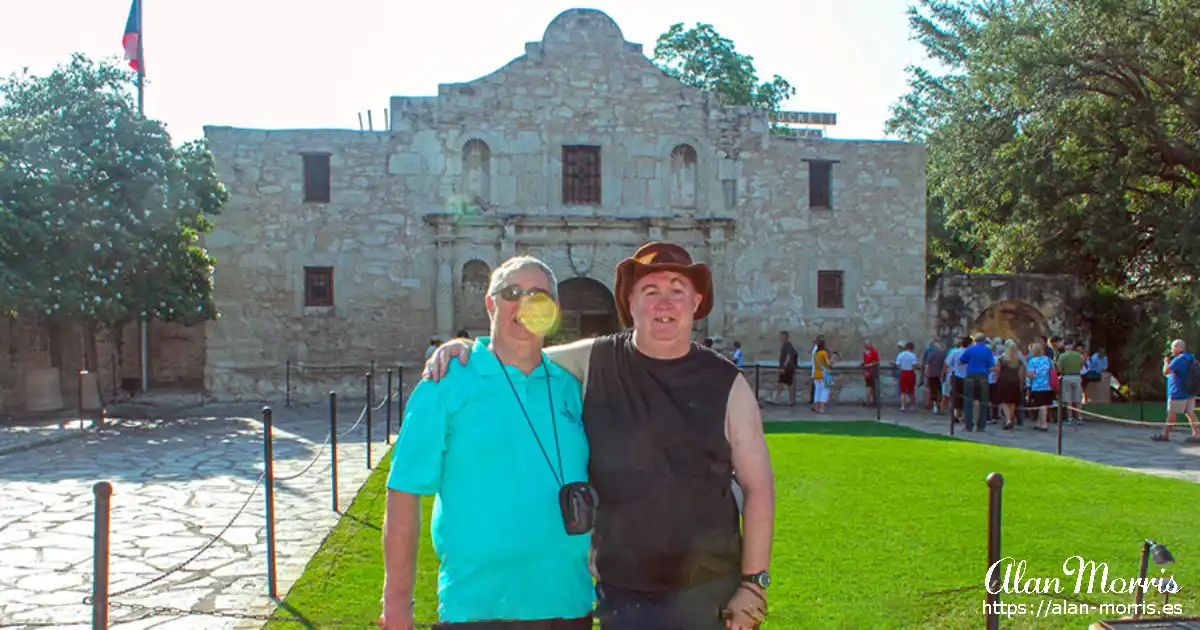I thought The Alamo was a fantastic place and would have liked to have spent more time there.
Our hotel was right opposite the Alamo and only a short walk across the square. We took a guided tour, and the guide told us a story about the outside garden area. It was very informative, but he told it in a humorous way that put us all in fits of laughter. I would love to visit again someday.
History.
The Alamo Mission in San Antonio, commonly called the Alamo, was initially known as the Misión San Antonio de Valero. It is a former Roman Catholic mission and fortress compound and the site of the Battle of the Alamo in 1836. The Alamo is now a museum in the Alamo Plaza Historic District of downtown San Antonio, Texas. Built by the Spanish Franciscan priest Antonio de Olivares and Payaya Indians, it is the origin of the present city of San Antonio, along with the Presidio San Antonio de Bexar and the Acequia Madre de Valero.
The compound, which initially consisted of a sanctuary and surrounding buildings, was built by the Spanish Empire in the 18th century for the education of area Native Americans after their conversion to Christianity. In 1793, the mission was secularised and then abandoned. Ten years later, it became a fortress housing a Spanish Army unit, the Second Flying Company of San Carlos de Parras, who likely gave the mission the name Alamo. This was early in the period of the Mexican War of Independence.
After independence from Spain was achieved in 1821, Mexican soldiers held the mission until December 1835, when General Martin Perfecto de Cos surrendered it to the Texian Army following the siege of Bexar. A relatively small number of Texian soldiers then occupied the compound. General Sam Houston believed the Texans did not have the manpower to hold the fort and ordered Colonel James Bowie to destroy it. However, he gave Bowie leeway to make his own logistical decision. Bowie decided to work with Colonel James C. Neill to fortify the mission (in part because there were not enough oxen available to move the cannons from the area). On February 23, 1836, Mexican General Antonio Lopez de Santa Anna led a large force of soldiers into San Antonio de Bexar and promptly initiated a siege. The siege ended on March 6, when the Mexican army overran the compound; by the end of the Battle of the Alamo, nearly all of the defenders had been killed. When the Mexican army retreated from Texas at the end of the Texas Revolution, several weeks later, they tore down many of the Alamo walls and burned some of the buildings.
During the Republic of Texas period, which overlapped a period of civil war in Mexico, the Alamo was used off and on by garrison soldiers, either Texan or Mexican, but it was ultimately abandoned. In 1849, a few years after Texas was annexed to the United States, the US Army began renting the facility as a quartermaster's depot. During the Civil War, the Confederate Army took over the site. The US Army regained possession after the war and used the facility until 1876, after nearby Fort Sam Houston had been established. The Alamo chapel was sold to the state government of Texas, which conducted occasional tours but made no effort to restore it. The other buildings were sold to a mercantile company that operated them as a wholesale grocery store.
After forming in 1892, the Daughters of the Republic of Texas began trying to preserve The Alamo. In 1905, Adina Emilia De Zavala and Clara Driscoll convinced the state legislature to purchase the remaining buildings and to name the DRT as the permanent custodian of the site. For the next six years, de Zavala and Driscoll quarrelled over how to restore the mission best, culminating in a court case to determine which of their competing DRT chapters controlled the Alamo. As a result of the feud, Texas Governor Oscar B. Colquitt briefly put the complex under state control and began restorations in 1912. The site was given back to the DRT later that year. The legislature took steps in 1988 and again in 1994 to transfer control of the Alamo to the Texas Parks and Wildlife Department. Still, the attempt failed after then-Governor George W Bush vowed to veto any bill removing the now-century-old DRT authority.
